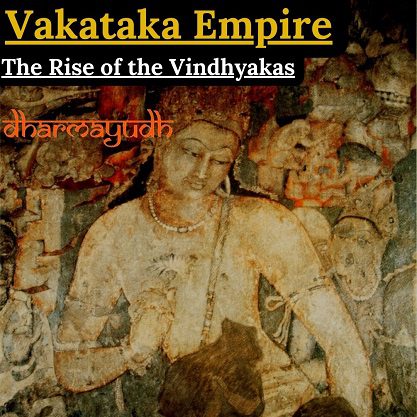Content
Background: Origin of the Vakatakas
In our previous articles, we shed light on some of the magnificent monarchs of the great Gupta Empire. The stories of Samudragupta and Skandagupta are filled with courage, benevolence, and generosity.

During the same period of the great Guptas, another empire emerged in the Deccan region. This kingdom which flourished around the Deccan region was a great patron of art, culture, and religion.
The Puranas had mentioned them as the Vindhyakas who were staunch followers of the Brahmanical tradition and culture.
The Vakatakas emerged around the 4th CE and were contemporary of the great Guptas. Like many other empires of Indian history whose origin remains ambiguous to this day the origin of Vakatakas is still a topic of debate.
Indian history is filled with anecdotes of the rise and fall of the kingdoms. There are some kingdoms whose stories have been lost in the pages of history.
The Vakataka kingdom is one of that kingdoms that despite achieving all the glory couldn’t able to register its place in the chapter of Indian history.
However, two theories shed light on the origin of the Vakatakas. The first theory mentioned that the Vakatakas belonged to the region south of the Vindhyas. While according to the second theory, their origin might be located north of the Vindhyas.
Early Rulers:
Ancient texts like the Puranas tell us a lot of information about the history of the Vakataka Empire. From the Puranas, we can inform the lists of various rulers of this empire.
The first ruler of the Vakataka dynasty is believed to be known as Vindhyashakti I. His name is also mentioned in the Puranas as the founder of the Vakataka dynasty.
He is known as Dvija and is considered a renowned military strategist of the Vakataka Kingdom.
Later he was succeeded by his son Pravarasena I or Pravira. Historians suggested that this new king probably had two capitals namely Chanaka (a city located in Madhya Pradesh) and Purika.
He also conquered the city of Vidisha from the Nagas and extended the territorial boundaries of the Vakataka Empire southwards.
To further enhance his hold on the empire and dominance king Pravarasena performed four Ashwamed sacrifices, seven Soma sacrifices, and one Vajapeya sacrifice (in this he donated a huge amount of land grant to the Brahmans).
Later he adopted the title of Samrat becoming the only monarch of the Vakataka kingdom who adopted this title.
He was also a great diplomat and to strengthen his empire’s foundations he married his grandson to the daughter of the Naga king Bhavanaga. Later this marriage alliance became an important political alliance for the sides.
Pravarasena ruled for about sixty years according to the Puranas. After him, his grandson became the next emperor.
At this time, the Guptas also emerged as a dominant force under the able leadership of Samudragupta in northern India.
The Split and the Famous Kings
The conflict between the Guptas and the Vakataks took place during the reign of Samrat Samudragupta. According to the famous Pryaga Prashasti inscription Vakataka king Rudradeva and Naga kings like Nagadatta and Ganapatinaga fought valiantly against the Gupta Emperor but in the end, they got defeated.

It is believed that from this defeat the Vakataka’s moved southward and split into two different branches. One branch set up its base in the Vidisha region under the leadership of Rudrasena I and was referred to as the Nandivardhana branch.
Later Prithvisena I the son of Rudrasena I entered into a matrimonial with the Gupta king Chandragupta II. Rudrasena II the son of Prithvisena I was married to Prabhavatigupta the daughter of Chandragupta II.
Another important king of this branch was Pravarasena II the son of Rudrasena II and Prabhavatigupta. He is believed to have founded a new capital at Pravarapura and even composed a Kavya known as Setubandha in the Prakrit language which tells the story of Lord Shri Ram’s victory over Ravana and his journey to Lanka.
The last known ruler of the Nandivardhana branch was Prithvisena II. He is believed to have revitalized the glory of the Vakatakas.
He fought against the Nala Dynasty, the Harisen of the Vastsagulma branch, and the Traikutaka King.
The second branch of the Vakataka located itself at Vatsagulma under the son of Pravarasena known as Sarvasena.
King Sarvasena was a renowned poet and is believed to have composed Harivijaya a lost work. He also adopted the title of Dharma-Maharaja.
The last king of this line of the Vakataka branch was the famous Harisena who is believed to have conquered the regions of Kuntala, Avanti, Kalinga, Kosala, Konkan, and Andhra. Furthermore, this ruler is credited to unify the two branches of the Vakataka kingdom due to which he is regarded as the greatest king of the Vastagulma branch.
The famous poet of the 6th century known as Dandin had described the character of Harisena as generous, mighty, and bountiful.
Administration and Legacy of the Vakatakas
The administrative structure of the Vakatakas was very similar to the Guptas. Their empire was divided into small provinces for better administration. These provinces were referred to as Rajyas or the Rashtras and were headed by governors called Rajyadhikritas.

The Vakatakas followed the Brahmanical culture and it is believed that it was their efforts that led to the rise of Brahmanical culture in south India.
The famous rock-cut Buddhist Viharas and Chaityas of the great Ajanta caves also belong to their period. They were a great patron of art, culture, literature, and architecture.
The famous painting titled Mahabhinishkramana depicts the vast knowledge of the Vakatakas in art and expressionism. Their painting styles led to the advancement of Buddhist art.
Donate to our Cause
If you support what we are doing and would like to contribute to help us grow and reach more Indians to teach them more about such forgotten historic Indian Heroes and stories, please consider donating any amount. It will help us grow.

